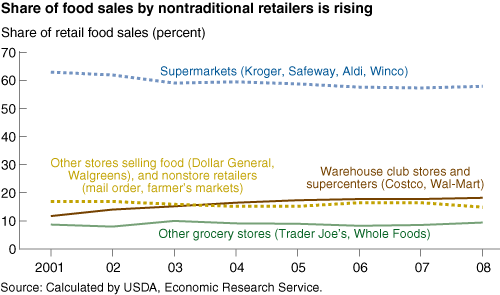Rising Food Prices and Economic Uncertainty Take Toll on Traditional Grocers
- by Annette Clauson and Phillip Kaufman
- 6/1/2009
Faced with tough economic times, many consumers are looking to stretch their budgets. Much of a family’s monthly budget—like rent or mortgage payments, utility costs, and car payments—is relatively fixed. Food-at-home spending—at $417 per month in 2007 for an average family of four—is one budget item where families can take steps to economize.
The growth of discount retailers has provided consumers with more options to cut monthly food spending. After a short recession in 2001, supermarkets’ share of retail food sales declined, while the food sales of stores promoting low prices and good-value foods jumped. Between 2001 and 2008, supermarkets’ share of total retail food sales fell from 62.8 to 57.8 percent. Over the same period, nontraditional grocers, such as warehouse club stores and supercenters, increased their sales share from 11.7 to 18.1 percent. The appeal of low prices and the convenience of one-stop shopping fueled the growth of food sales by supercenters and warehouse club stores.
As prices for many food staples rose sharply in 2007 and 2008, consumers searched for new ways to reduce grocery spending. Price-oriented, limited-assortment supermarkets like Aldi and Sav-A-Lot saw gains in total sales (including nonfood sales) of 16.2 percent in 2007, up from an 8.3-percent gain in 2006, according to Willard Bishop Consulting. Similarly, superwarehouse supermarkets, such as Cub Foods, Food 4 Less, and Winco Foods, increased their total sales by 14.1 percent in 2007, up from a 2.2-percent decline in the prior year. A superwarehouse supermarket, is a hybrid of a large supermarket and a no-frills warehouse store. Meanwhile, sales by all supermarkets were up only 3.0 percent in 2007.
Bargain food shoppers also sought out no-frills, deep-discount retailers that sell branded food manufacturers’ surplus goods, inventory overstock, and reclaimed goods from other retailers. Still other stores specialize in “salvaged” or damaged products, such as dented cans from large, brand-name food manufacturers. Food sales by stores selling surplus, overstocked, or damaged products are a small percentage of U.S. retail food sales, but they play a growing role in stretching some consumers’ food dollars. Amelia’s Grocery Outlet, a salvage food chain in Southeastern Pennsylvania, reported a 25-percent increase in sales in 2008, up from a 17-percent gain in 2007.
Although at-home food prices are expected to moderate in 2009 from their 6.4-percent increase in 2008, the prospects for economic uncertainty and recessionary conditions are likely to continue the shift in food spending to discount supermarkets and nontraditional stores.
This article is drawn from:
- Consumer and Producer Price Indexes. (n.d.). U.S. Department of Agriculture, Economic Research Service.
- Food Prices, Expenditures, and Establishments. (n.d.). U.S. Department of Agriculture, Economic Research Service.
We’d welcome your feedback!
Would you be willing to answer a few quick questions about your experience?


